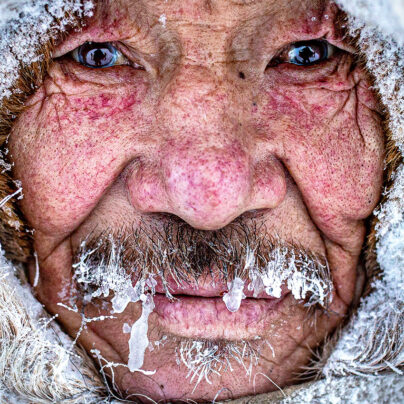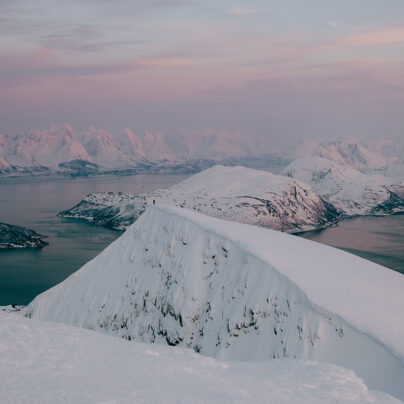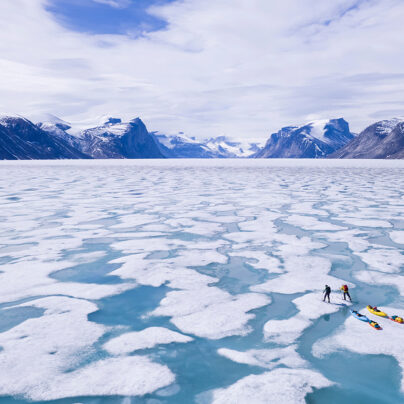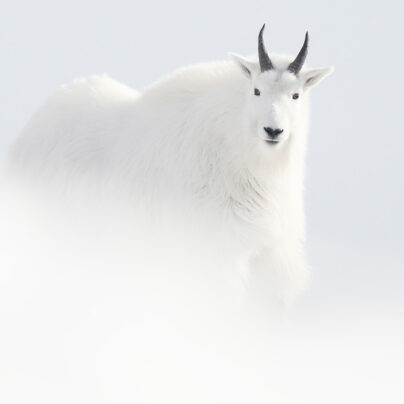Everything is Connected
Nature’s Eyes and Ears in Svalbard
Story & Photography: Florian Ledoux // Written by Alex Roddie
It is around midnight when our boat arrives at the southern point of Svalbard, and my friend and I are both pretty much destroyed. With just the two of us sailing Eliot we have each had three hours on shift and then three hours of sleep. Usually good for three people, our 11m craft is more comfortable for two in Arctic waters, at the expense of sleep. But when I look up and see Eliot’s bow cutting through the dark waters – dark waters reflecting towers of ice that rise up where the snout of a glacier meets the sea – I feel a great boost of energy lifting me out of the exhaustion. As if the sight of the ice has triggered an adrenaline surge in my body.
Fog rolls in as we approach the glacial front, and the midnight sun fades away to create a delicate atmosphere above the ice – all subtle shapes of frosted glass. But I’m wary. We are sailing towards our first glacier of the season. This bay is uncharted, and we’re navigating in shallows where the glacier once terminated, before glacial retreat pulled back the ice. Now a chaotic underwater moraine has left question marks beneath the surface. We creep through with great care and finally anchor in a magnificent location facing a blue wall of vertical ice. It is everything I had hoped for in an arrival. Almost too good to be true.
But the next morning, as we sail slowly out of the bay, taking every precaution in the shallow water, a jarring crunch shudders through the boat’s keel. I feel the vibration in my bones. My friend and I share a look of alarm. A rock, I think. ‘The hull,’ he says. I share the worry I see in his eyes – serious damage to the boat out here doesn’t bear thinking about. We stop and we check everything. The retractable keel has broken on top of its hydraulic arm. Nothing vital, but now we can’t raise the keel any more, and it’s stuck out a few degrees beyond its normal extension.




Nature has ears and eyes. Everything is part of everything else. The Arctic may feel desolate, but it is full of life – you just have to find it
Our journey has started with wonder and beauty but also a reminder of how one must always be vigilant in the Arctic. Every year, larger boats run aground and get stranded. I love this side to the immense Arctic wilderness, tinged with risk. I love, too, the idea that barely any humans come here. I love the never-ending feeling of exploration, and yet the sense of never being alone. Nature has ears and eyes. Everything is part of everything else. The Arctic may feel desolate, but it is full of life – you just have to find it.
***
There are places that will mark you. Places that, once you witness them, leave a deep impression, changing your view of the world forever. The Svalbard archipelago is one of these places. The last land north of Europe before the North Pole, this archipelago is a unique territory in the Arctic, offering a variety of landscapes and fauna like nowhere else in the far north.
At the end of May, in Tromsø, all of my summer plans changed when I met my future sailing companion. We decided to set off together on a last-minute sailing expedition to Svalbard. The pandemic had put an end to all my trips that year – as it had for most of my fellow photographers – but Svalbard remained a possibility, because my new friend and I were both based in Norway. To the rest of the world it remained closed. This year, I knew, Svalbard would be almost deserted, with hardly any other boats. I was eager to discover this place once again – and to taste its wonders in solitude, with just the two of us aboard a small vessel. I knew the potential that Svalbard had to offer. I wanted to go back to study its wildlife and to see what had changed since my last visit.
First we had to do a few weeks of work on the boat, Eliot. It began with taking her onshore to clean and repaint the hull, as well as swapping out some parts, then loading up with provisions for more than a month (including alcohol, as good sailors do). The next step – a long one – was studying the weather, sitting tight and quiet, waiting for our moment. We spent hours each day monitoring the weather systems in the North Atlantic and Barents Sea. It felt hard, frustrating at times, but eventually we saw that with good timing we might be able to sneak through all the low-pressure systems and their strong headwinds. It was a tense time. I was nervous that the weather would punish us in our crossing, but excitement bubbled within me.
During our crossing, the forecast changed, relayed to us by a friend on land. One of the low-pressure zones forced us to divert to the uninhabited island of Bjørnøya and find shelter in the south bay, Sørhamna. We stayed for 24 hours, resting and making French pancakes. As the tail of the low pressure veered north, we used it to sail with the wind – and on towards our destination.



‘What’s that?’ my friend calls to me, and I follow his pointing finger until my gaze meets the shoreline. There is a mass of animals clustered there – great heaving brown bodies piled up on the beach. Walruses. An entire colony of them.
After our close call with a broken keel, we had continued sailing from fjord to fjord, visiting place after place that I had never seen before. That feeling of discovery doesn’t leave me. For weeks until we arrive in the main fjord of Longyearbyen, the biggest settlement, we don’t meet a single other boat – something that has never happened to me in Svalbard before. The solitude amplifies our sense of exploration.
I’m excited by the prospect of getting close to a colony of walruses and documenting this large mammal of the North Atlantic from a new perspective. Through the binoculars, I think I can count around 60 individuals lying on the beach, even though I know we usually underestimate numbers. We edge the boat closer to the shore but it’s still difficult to count them.
I start to focus on individuals through the glasses: one staring imperiously down its moustachioed jowls at a neighbour, another scratching its ample belly with a flipper. They look comically ugly – and the very essence of laziness as they lounge gracelessly on the shore. From past experience I know that they smell bad too. However, I’ve been fascinated by walruses since I first saw them. They display a wide and interesting range of behaviour, and can even be cute when you take a closer look. Often the most vivid sensory impression these massive animals make is through sound. Roars, grunts, gurgles, grumbles, toots: walruses vocalise constantly, and they burp almost as often. Get close enough and the sound is so loud that it seems to resonate in your body. Goosebumps race across the skin of my arms as I listen to the noise of the colony on the beach.
Finally I’m able to fly the drone overhead and capture some images from an unusual perspective. It’s a big surprise. The aerial images reveal just how many animals there are in a single colony, with over 210 individuals on the beach and 450 in the bay – females with pups.
Immersed in remote polar regions, close to animals like walruses and taking the time to understand them, are the moments when everything makes sense to me. As a photographer, too, the urge to create an image with a strong message, that I will remember for the rest of my life, comes naturally in these moments.
Walruses were once abundant in the Svalbard archipelago. In 1952, after 350 years of commercial exploitation for their ivory, they were on the verge of local extinction, when – finally – they were granted total protection. Despite having been protected now for almost 70 years, walrus numbers are still low in Svalbard by comparison, and they remain on the Norwegian National Red List. However, their population is growing. The latest study, made in 2018 by the Norwegian Polar Institute, revealed an estimated 5,503 walruses within the Svalbard area – and from my perspective, using drones to count them in the different bays, I believe there might even be more than the last counting. Every time I go to Svalbard, meeting locals and talking to friends there, I notice that not only have walrus numbers increased, but I am also seeing them in more locations. When nature is protected, it has great resilience. Ecosystems are capable of rapid recovery.




The polar bear is just standing there on the edge of a large iceberg, his textured fur not as white as you might expect against the brilliant blue-white of the ice, and at first we think he is resting. The boat edges closer. Now I see that the bear is ready to jump on a seal in the water below. Every atom of his attention is focused on the prey animal, but it is too far away – the bear can’t reach it. As I study the bear I can feel his wisdom and knowledge. He knows that he won’t succeed in his hunt at this moment, so instead he watches calmly, his body relaxed. Perhaps next time he’ll have better luck.
Tears spring to my eyes despite the cold. Every encounter with a polar bear is unique; every encounter is incredible in its own way. Standing before this animal, meeting the great wanderer of the extreme at such close quarters, is one of my favourite feelings in life
Tears spring to my eyes despite the cold. Every encounter with a polar bear is unique; every encounter is incredible in its own way. Standing before this animal, meeting the great wanderer of the extreme at such close quarters, is one of my favourite feelings in life. I’m witnessing the perfect blend of ultimate power and fine tenderness in one body. The more time I spend with polar bears –and, to an extent, with all wildlife – the greater my conviction that they are more similar to us than we think.
You can’t spend time in Svalbard without seeing a polar bear. I always tend to forget them in summer, but they are still there, everywhere and nowhere at the same time, roaming in surprising places. They could be far north on the sea ice or, if they stay on the land, they might be seen swimming in the inlets. Or you might even spot them in an unusual green place, right at the bottom of a cliff thronged with guillemots and other seabirds. In this season the chicks learn how to fly. They will jump off the cliff to hopefully meet their parents in the water below. But if an opportunistic bear is waiting at the bottom, it will snatch the chicks that crash onto the ground.
The key to the polar bear’s evolution and survival in these extreme environments has always been adaptation. As conditions change, polar bears spend more time on land and seek out different options. I have observed them hunting reindeer on several occasions, even when there was lots of sea ice. I have also observed a few bears hunting in walrus colonies. However, their main source of food remains the energy-rich fat of seals, which they find in abundance on the sea ice in spring.
Over the years working with polar bears, I have learned about their great capacity to adapt, but I have also learned that other factors threaten the species, such as the pressure from hunting. The polar bear was protected in Svalbard in 1973 – it is now only legal to shoot one in self-defence – but elsewhere the species has received very little protection. More than 1,000 polar bears are still killed each year across the Arctic today, and almost 31,000 polar bears have been killed worldwide since I was born.
***
One thing you don’t expect in the Arctic is to find yourself sunbathing topless on the deck of the boat. For me, sailing has always been a way of exploring the polar regions I find so magnetic – and therefore in my mind it’s always been linked to suffering. To being wet, cold, and miserable. Except this year when temperatures are slowly but inexorably going up.
We wake up at the entrance of Isfjord, one of the large fjord systems on the west coast where Longyearbyen is located. The sun, which doesn’t set here from mid-April until the end of August, is already high and strong in the sky, and we both take breakfast outside on the deck with our T-shirts off. My friend smiles at me but his expression is half appreciation for the warmth, half a deep unease. ‘Soon people will be coming here instead of the Mediterranean,’ he says after a moment.




Days later, moored at Longyearbyen and spending a bit of time in Svalbard’s largest town – a cluster of colourful houses and industrial buildings with a population of around 2,300 – the temperature suddenly climbs to 21.7°C, a temperature never before seen in the Norwegian Arctic. Aboard Eliot, a thermometer exposed to the sun reads 26°C and I can’t help feeling a prickle of fear as I look at the instrument again and again, not quite trusting my eyes. It’s insane, I think, although my body rebels, responding to the warm sunshine with pleasure – I live in the Arctic all year round and I can’t help it. I know that the summer average temperature in a place like Svalbard is around 10°C. Sometimes snow falls in July or August. Longyearbyen is only 1,300km from the North Pole.
That night, I go to a beach party with some local friends. We crack open some beers. Music from a Bluetooth speaker carries over the stony beach. It’s calm. Flip-flops, shorts, and no T-shirt, facing the midnight sun hanging in a clear sky over the sea. Conversation ebbs and flows, but that same sense of unease surfaces again and again – I see it in glances out to sea, in awkward smiles. For a while I convince myself that we aren’t in the Arctic at all but somewhere else. Somewhere south. Spain, perhaps.
***
Eliot sails on into the summer, and the warm temperatures persist. We sail close to where the ice cliffs of the Austfonna glacier crumble into the sea, where gigantic waterfalls thunder from rivers that meander for many kilometres over the surface. The heat is accelerating the rate at which this ice cap melts. I send up the drone again, and capture surprising images of the blue rivers that snake between crevasses and a million isolated pools. It’s a curiously organic surface, like the cross-section of a living thing’s flesh. As I look at the images from the drone, I realise that glaciers are exposed to the sunlight for 24 hours a day. No shade ever protects them. The melt is remorseless.
There is so much beauty and elegance in the pack ice that surrounds us in the sea. It is constantly evolving, and is a sensitive component of the Arctic climate due to its high albedo effect – light-coloured surfaces reflect away more of the sun’s energy – as well as its insulating powers, reducing heat exchange from the ocean to the atmosphere. In the Arctic, as elsewhere, everything is connected.
***
After almost a month of navigation, more than 2,500km covered, and incredible wildlife encounters, we finally returned to the port of Longyearbyen where I disembarked from Eliot. A week later I continued on another ship to document the change happening in the Arctic.
Every Arctic expedition I do anchors my love for this place more deeply. It is a temporary open-field art museum created by the ever-changing beauty of the ice. That summer I realised that I feel a burning desire to use my heart and soul to capture the essence of the art nature has created right in front of us – and I realised that ice itself is the main reason for my polar obsession. Ice is the base of a complex ecosystem here in the Arctic, but also of the stability of our entire planet. After the dramatic changes I witnessed during this summer expedition I feel even more responsibility to do something, both on a personal level to minimise my own impact, and also to educate and share my love for the polar regions so it can help people to take action.
All living species on the planet grow and prosper in association with other species. A tree needs a certain climate and a certain type of soil; Arctic fauna needs ice. Humans need this interconnectivity too. Our survival does not depend on only one ecosystem but on all the ecosystems of our planet, and our own impact on these ecosystems begins with the disruption of the polar regions. We must reverse our impact now before we cross points of no return.
From all the experiences I have had in the wild places, I can tell you that when we cherish nature fully, it has far more to offer us than merely resources. Nature can nourish us deeply. It can help us to find an inner balance to live in joy and harmony.
And my polar obsession? I can’t get away from it, and spent the whole of the following winter season up there on the ice. Long live the Arctic.
First published in Sidetracked Volume 23
Story and photography by Florian Ledoux // en.florian-ledoux.com // @florian_ledoux_photographer
Written by Alex Roddie // @alex_roddie







